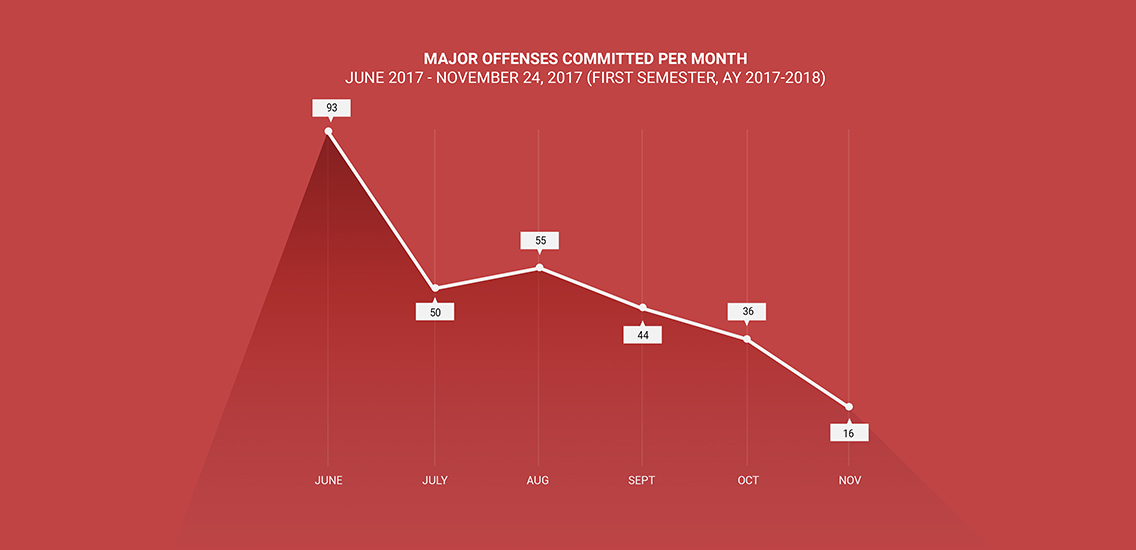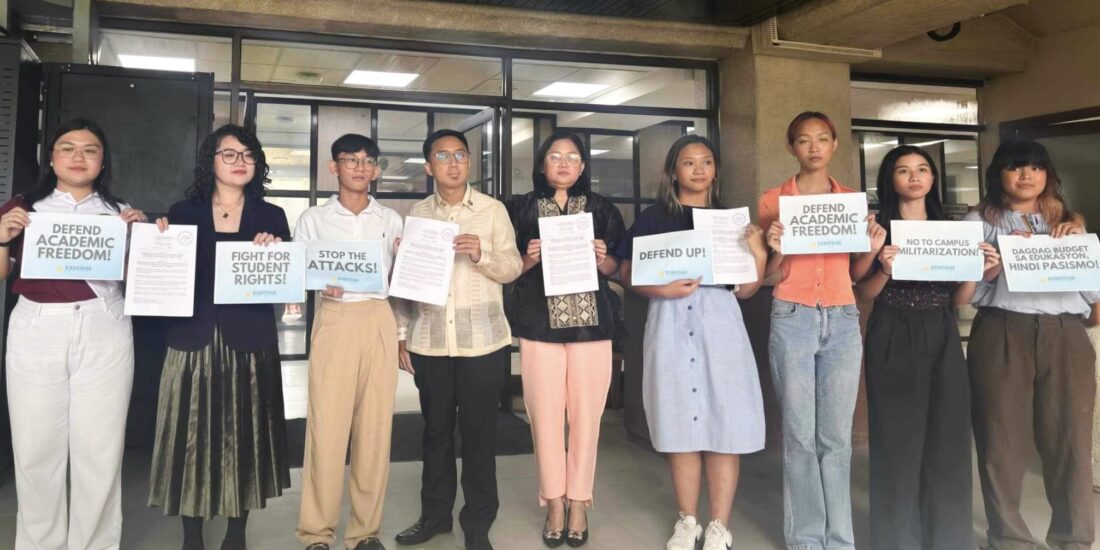294 major offenses recorded by SWAFO this sem
The Student Welfare and Formation Office (SWAFO) has recorded a total of 294 major offenses in the University from the first semester of this academic year (AY) 2017-2018 as of November 24, according to SWAFO Director John Casidsid.
With a total of 19 violations recorded for the 294 major offenses, the top three causes of major offenses include commission of third minor offense, violation of conditions of being under probation, and commission of second major offense, with 157, 68, and 18 frequencies, respectively.
“That means, according to the [DLSU-D 2014-2018] Student Handbook, if you commit four minor offenses, [then] it’s already equivalent to one major offense. Kasi sa handbook, dito, nakalagay, the first minor offense that you will be committing, you will just be given a verbal warning… second offense will be considered as your first minor offense. And then, third (minor) offense will be considered as the second minor offense… the fourth violation will be considered third minor offense which is equivalent to one major offense. And many of our students [are] committing many minor offenses,” Casidsid explained.
Most common violation
According to the SWAFO director, the most frequently committed minor offense that leads to commission of major offenses are ID-related instances such as lending of IDs to other DLSU-D students with different identities or to outsiders, improper wearing of IDs, and not wearing IDs.
“So, sabi ko hulihin nang hulihin (students violating the rules) kasi we have to teach them discipline with regards to IDs. And besides, napakalaki ng campus natin. Hindi natin alam kung sinong pumapasok dito [sa campus],” he said.
Moreover, Casidsid discussed that the use of certificates of registration (CORs) in place of IDs is “rampant”, causing students to commit more major offenses. As Casidsid explained, some students frequently print their CORs to lend their IDs to other students or outsiders.
“Kaya ngayon nagdo-double time kami para talaga ma-check. Eh, you can re-print your COR anytime, how many times sa labas. Kaya ‘yong mga estudyante, tingnan mo ha, pinapagamit nila ‘yong kanilang COR. Hindi naman nache-check [ng guards]. Walang picture ‘yan eh. Kaya nga ang sabi ko din, sana puwede bang COR (to use in place of school IDs) plus any [valid] ID.
To further resolve the issue, Casidsid has discussed the matter with the Office of the University Registrar.
“In the second semester, hindi na puwede na i-allow naming pumasok ‘yong mga [student who print their CORs outside]. Ang puwede [na lang ay official] COR forms to be officially given by the Registrar. So, isa na lang ‘yon. So, hindi ka na puwede mag-print sa labas at gagamitin mo dito.”
Offenses per college
Among the seven colleges, the College of Business Administration and Accountancy (CBAA) holds the highest number of violations in the past two AYs, with a total of 94 major offenses committed in the first semester of AY 2017-2018, as of November 24.
With that, Casidsid explained, “Kasi nga napakahigpit with regards to their business attire. Wala kalang necktie, minor offense [na]. ‘Pag ‘yong sapatos mo ay flat shoes, minor offense, ‘di ba? … Commission of third minor offenses lead to one major offense. Eh, ang daming estudyante nila (CBAA). ‘Di ba? Kwan nalang din ‘yon, parang logical. Marami sila so masmaraming magko-commit.”
As per Casidsid, around 400 IDs were confiscated when they first implemented the guidelines on the appropriate business attires for the CBAA students.
“That was to teach them, to discipline them, and to follow what the norm of their dean wanted to impose to their students,” he added.
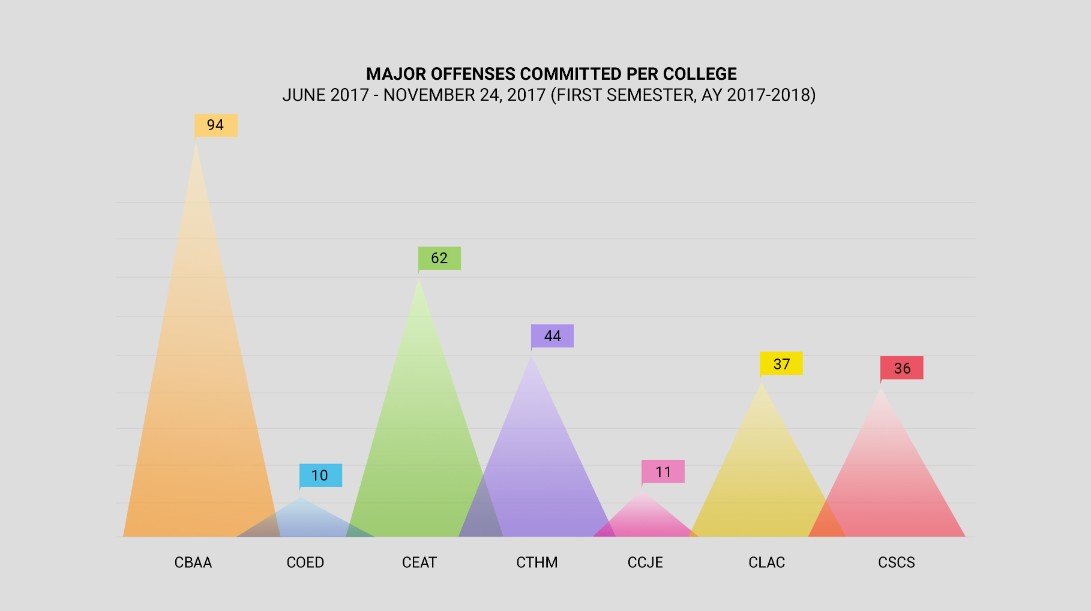
As of first semester of AY 2017-2018, CBAA, College of Engineering, Architecture, and Technology (CEAT), and College of Tourism and Hospitality Management (CTHM) topped the list of colleges with the most major offenses committed from June 2017 to November 24, 2017. The College of Liberal Arts and Communication (CLAC) and College of Science and Computer Studies (CSCS) scored midrange in comparison to the College of Education (COEd) and College of Criminal Justice Education (CCJE) which received the least number of major offenses this year.
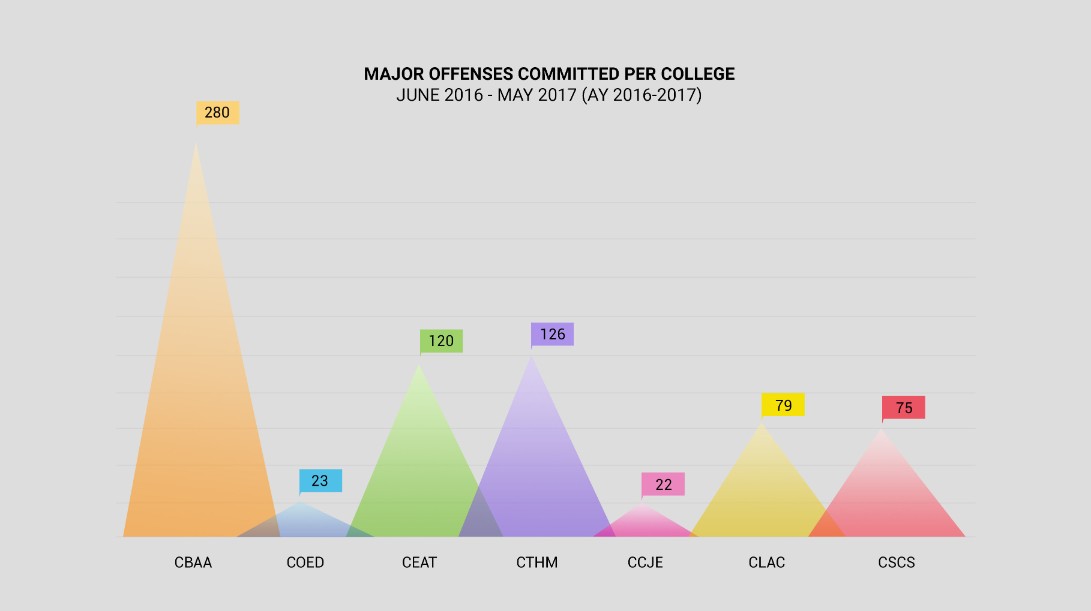
In the previous AY from June 2016 to May 2017, CBAA topped the list for the second time being the college with the most major offenses committed, followed by CTHM and CEAT in the second and third spot, respectively. Meanwhile, the lowest number of offenses occurred in COEd and CCJE again.
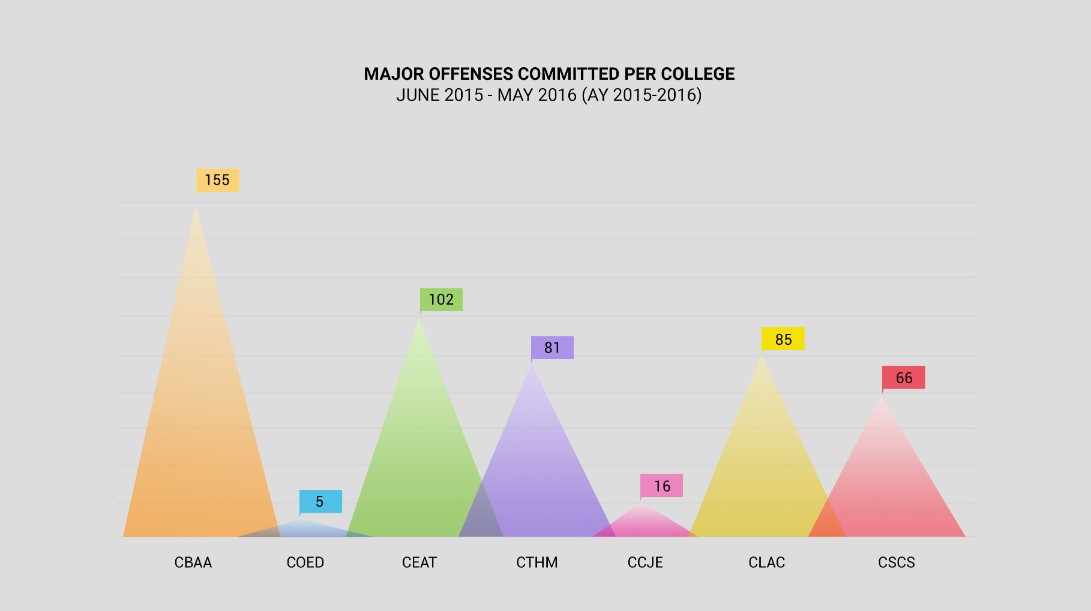
From June 2015 to May 2016, the total number of major offenses committed per college remained consistent with the trend with CBAA at the top spot, followed by CEAT and CTHM.
Offenses per month
The following graphs depict the number of major offenses committed per month during June 2017 to November 2017, June 2016 to May 2017, and June 2015 to May 2016.
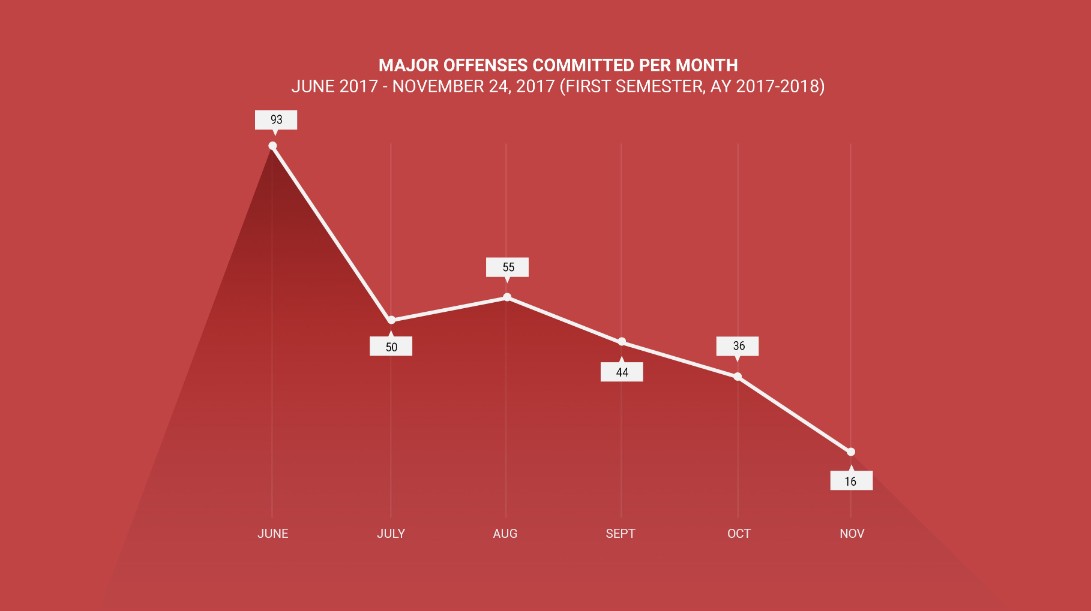
In June 2017 to November 2017 of the current academic year, the highest number of offenses occurred in June during the summer class period of the semester, followed by August wherein the AY officially resumed and students returned to campus. As of November 24, the total number of offenses accumulated in the first semester is 294.
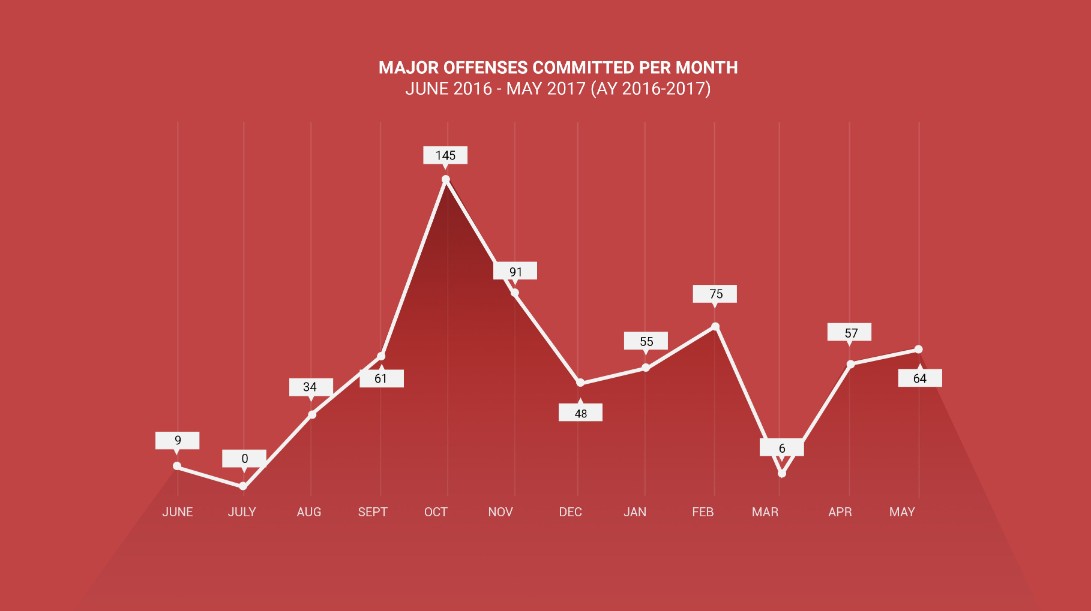
In AY 2016-2017, there was a significant spike in the month of October in the first semester, and February in the second semester. A total of 725 major offenses were accumulated over the course of the entire AY.
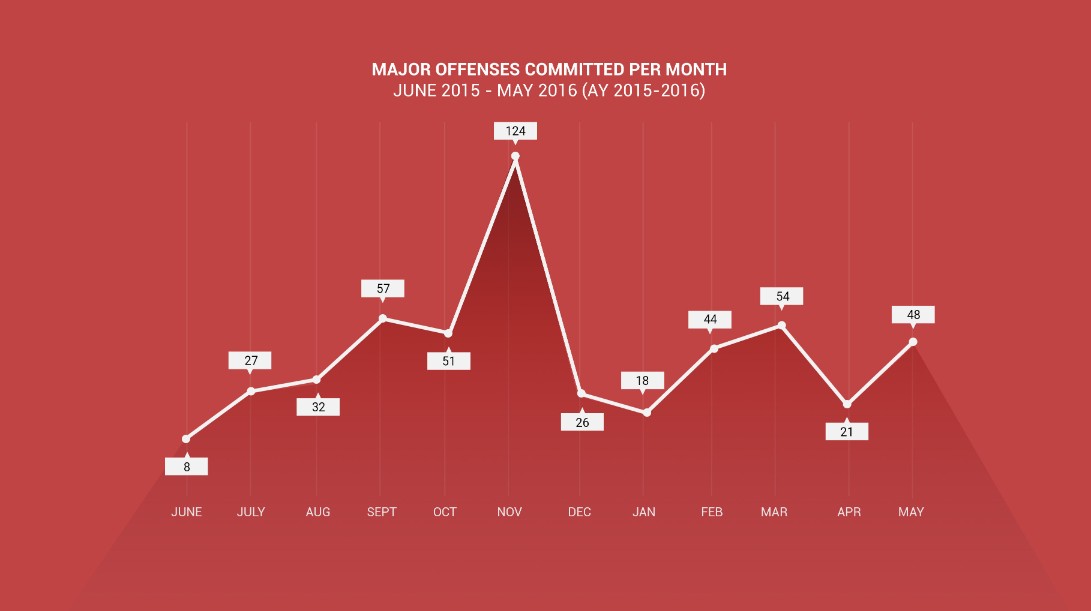
Meanwhile in AY 2015-2016, there was a significant spike in the month of November in the first semester, and March in the second semester. A total of 510 major offenses were accumulated over the course of the entire AY.
Per offense and sanction
The following tables present the nature of major offenses committed as well as the sanctions of said violations from June 2017 to November 2017, June 2016 to May 2017, and June 2015 to May 2016.
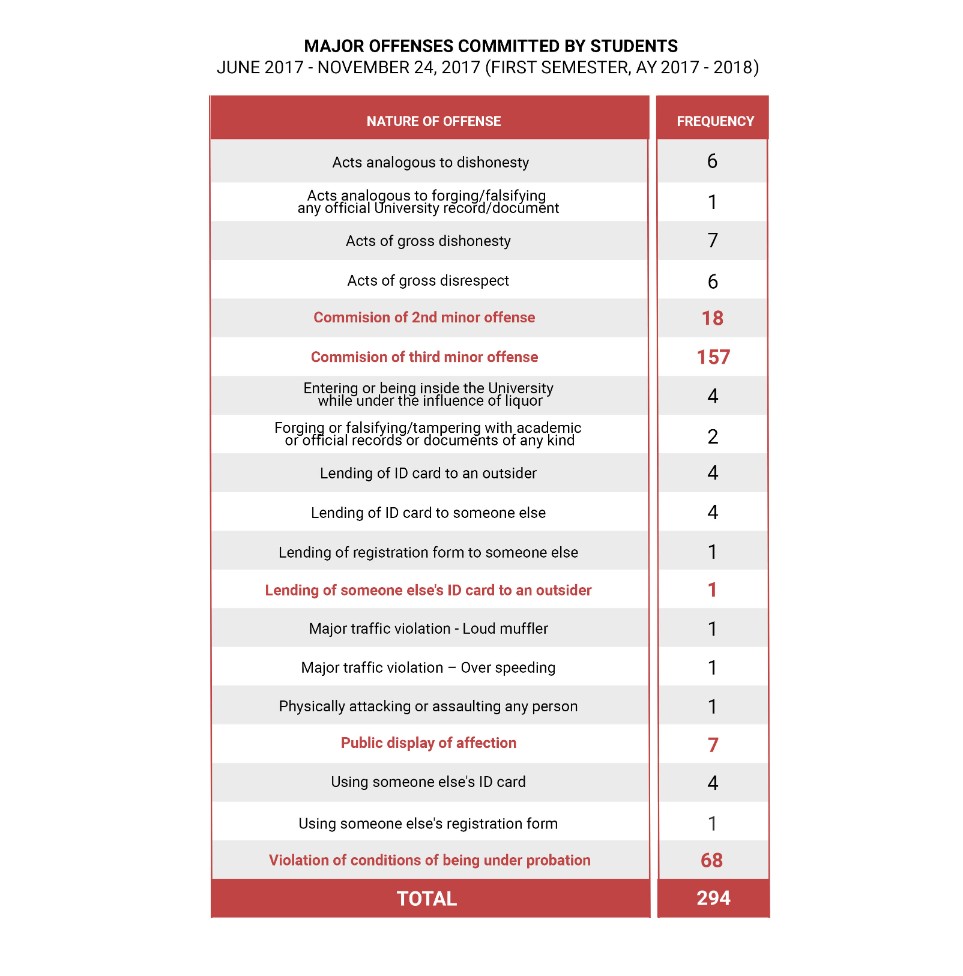
The leading causes of major offenses from June 2017 to November 2017 (AY 2017-2018) were commission of third minor offense with 157 violations, violations of conditions of being under probation with 68 violations; commission of 2nd major offense with 18 violations; and acts of gross dishonesty and public display of affection with 7 violations each.
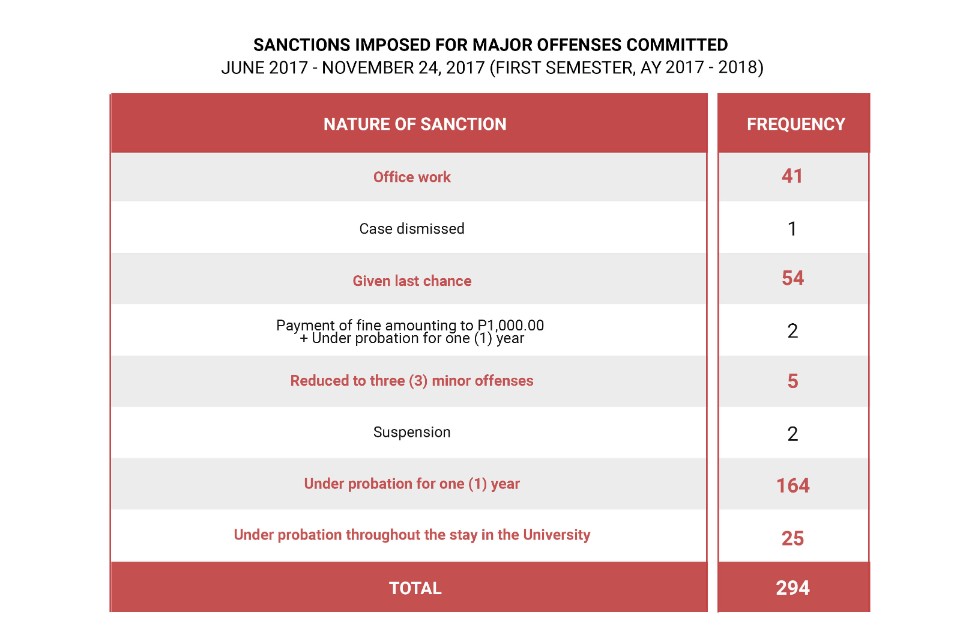
In the same academic semester, the five most frequently imposed sanctions for the 294 major offenses from June 2017 to November 2017 include being under probation for one year with 164 cases; given last chance with 54 cases; office work with 41 cases; under probation throughout the stay in the University with 25 cases; and reduction to three minor offenses with 5 cases.
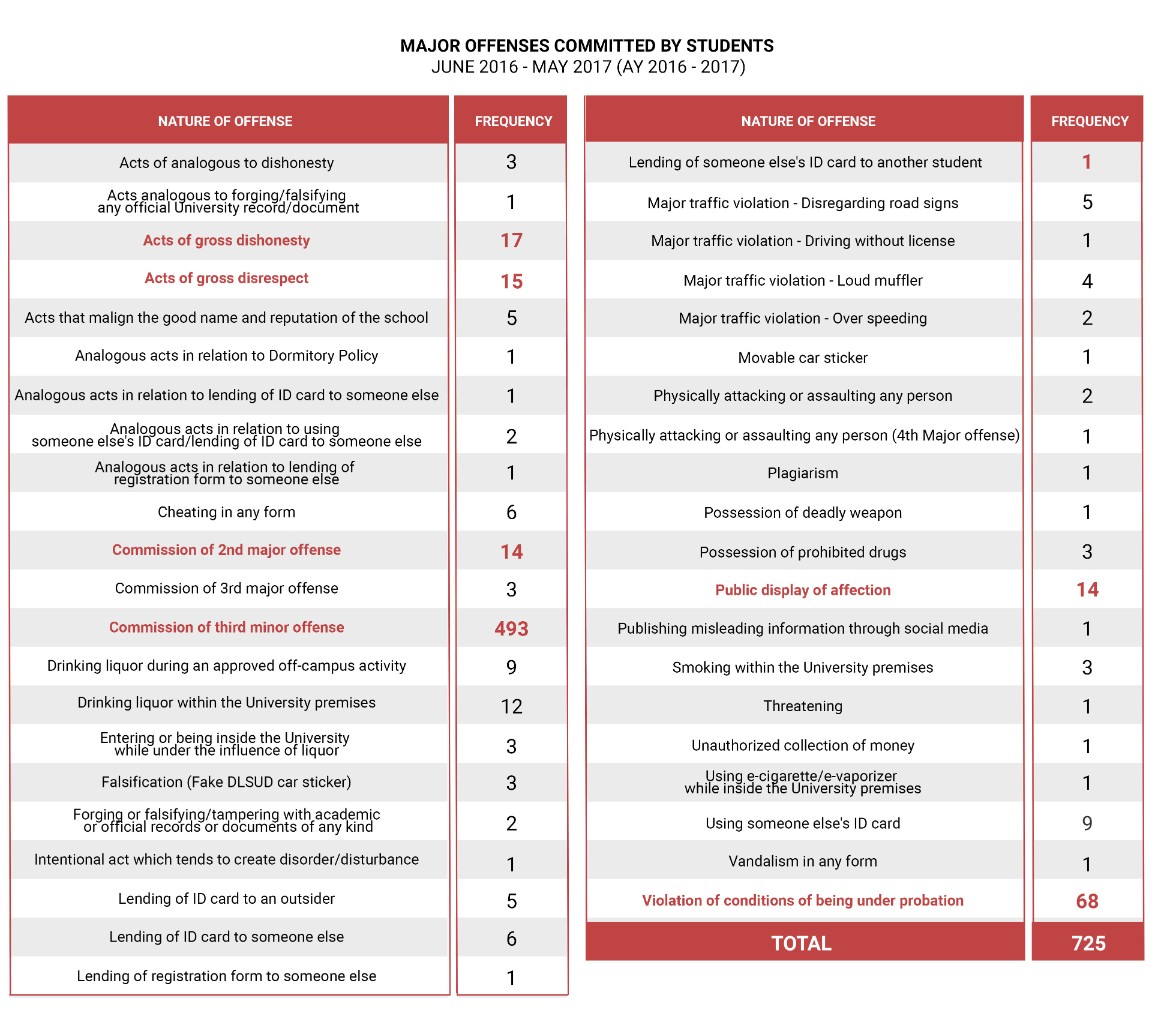
The leading causes of major offenses from June 2016 to May 2017 (AY 2016-2017) were commission of third minor offense with 493 violations; violations of conditions of being under probation with 68 violations; acts of gross dishonesty with 17 violations; acts of gross disrespect with 15 violations; and commission of 2nd major offense and public display of affection with 14 violations each.
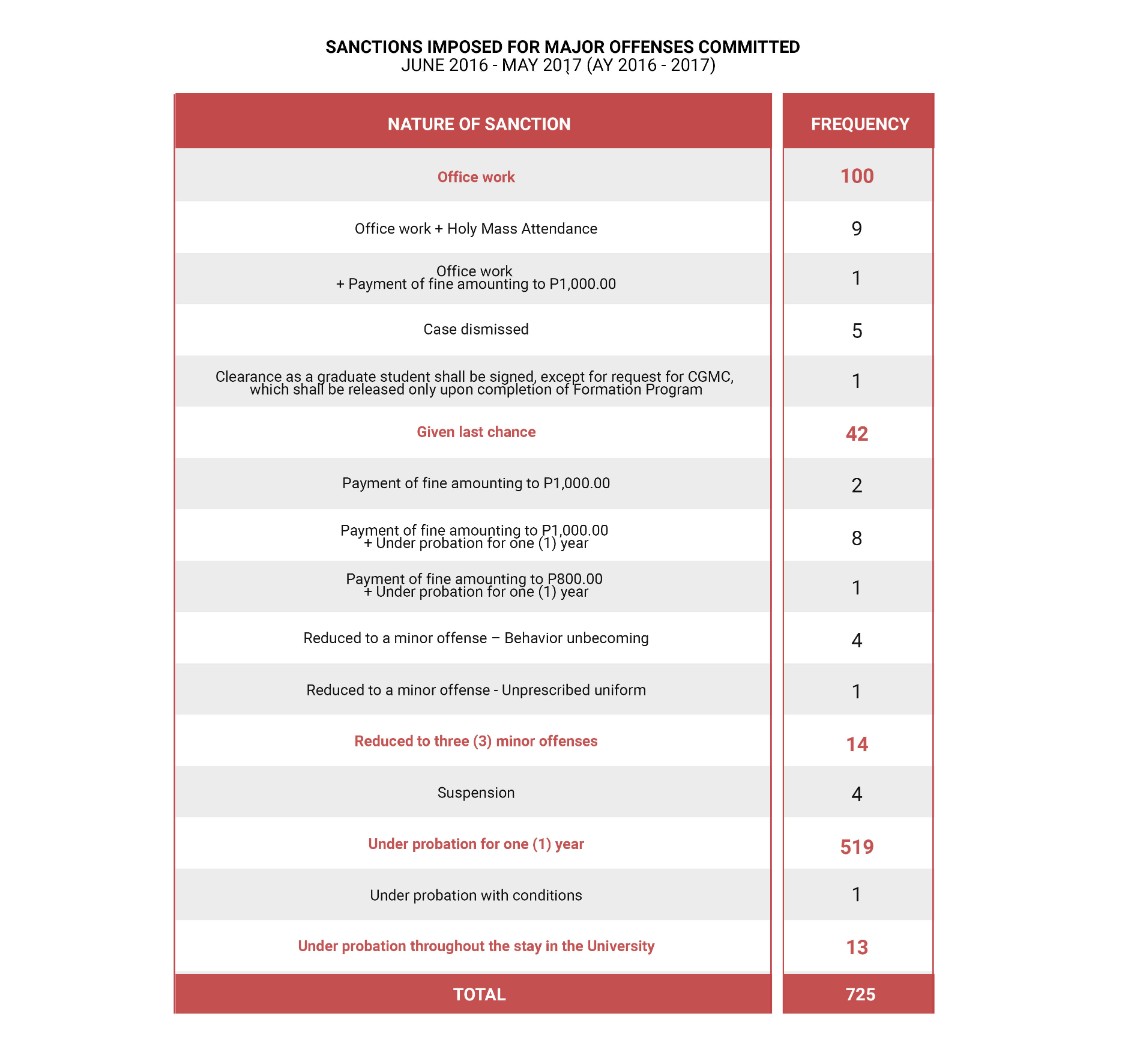
In the same AY, the five most frequently imposed sanctions for the 725 major offenses from June 2016 to May 2017 include being under probation for one year with 519 cases; office work with 100 cases; given a last chance with 42 cases; reduction to three minor offenses with 14 cases; and probation throughout University stay with 13 cases.
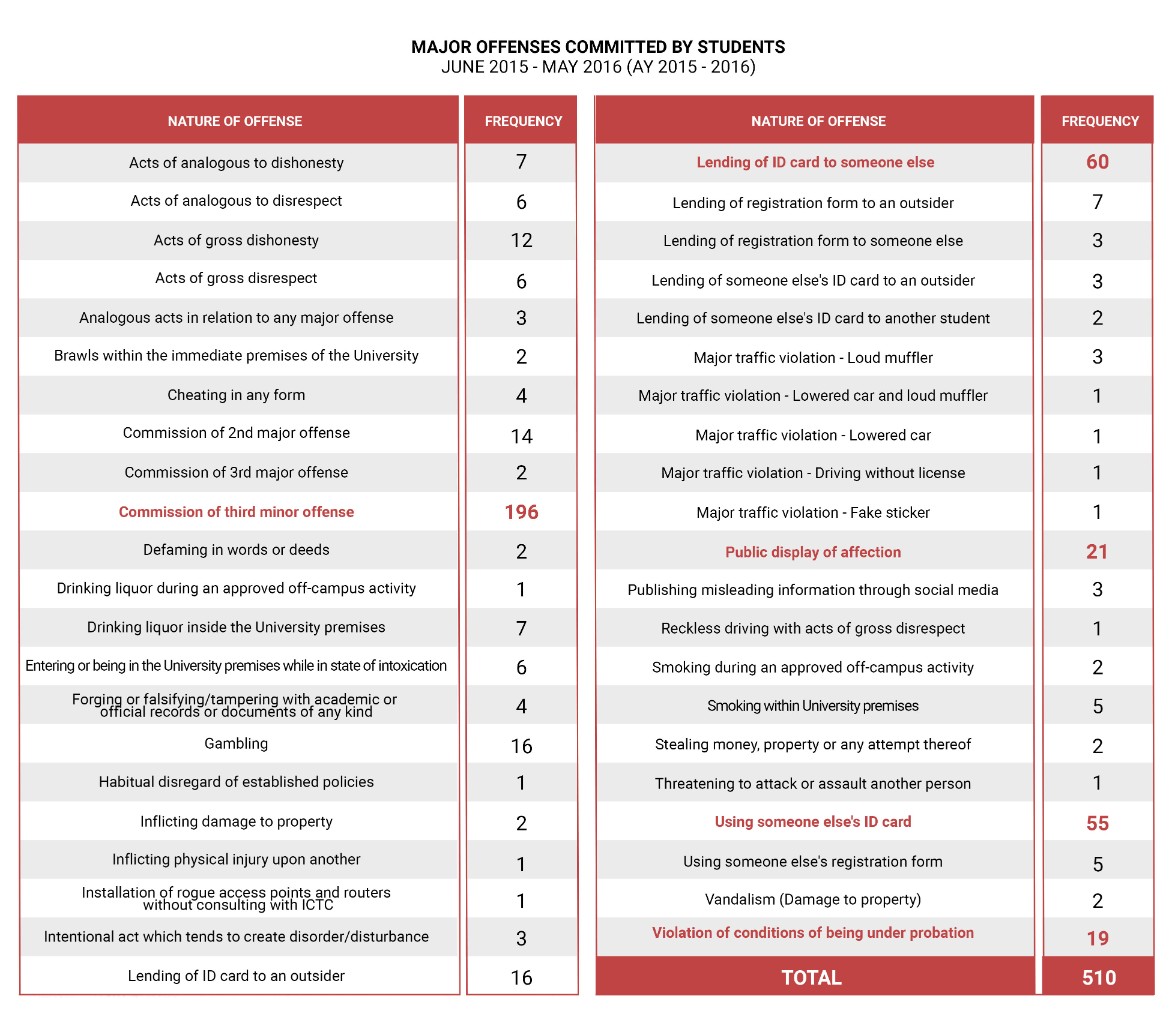
The five leading causes of major offenses from June 2015 to May 2016 (AY 2015-2016) were commission of third minor offense with 196 violations; lending of ID card to someone else with 60 violations; using someone else’s ID card with 55 violations; public display of affection with 21 violations; and violation of conditions of being under probation with 19 violations.
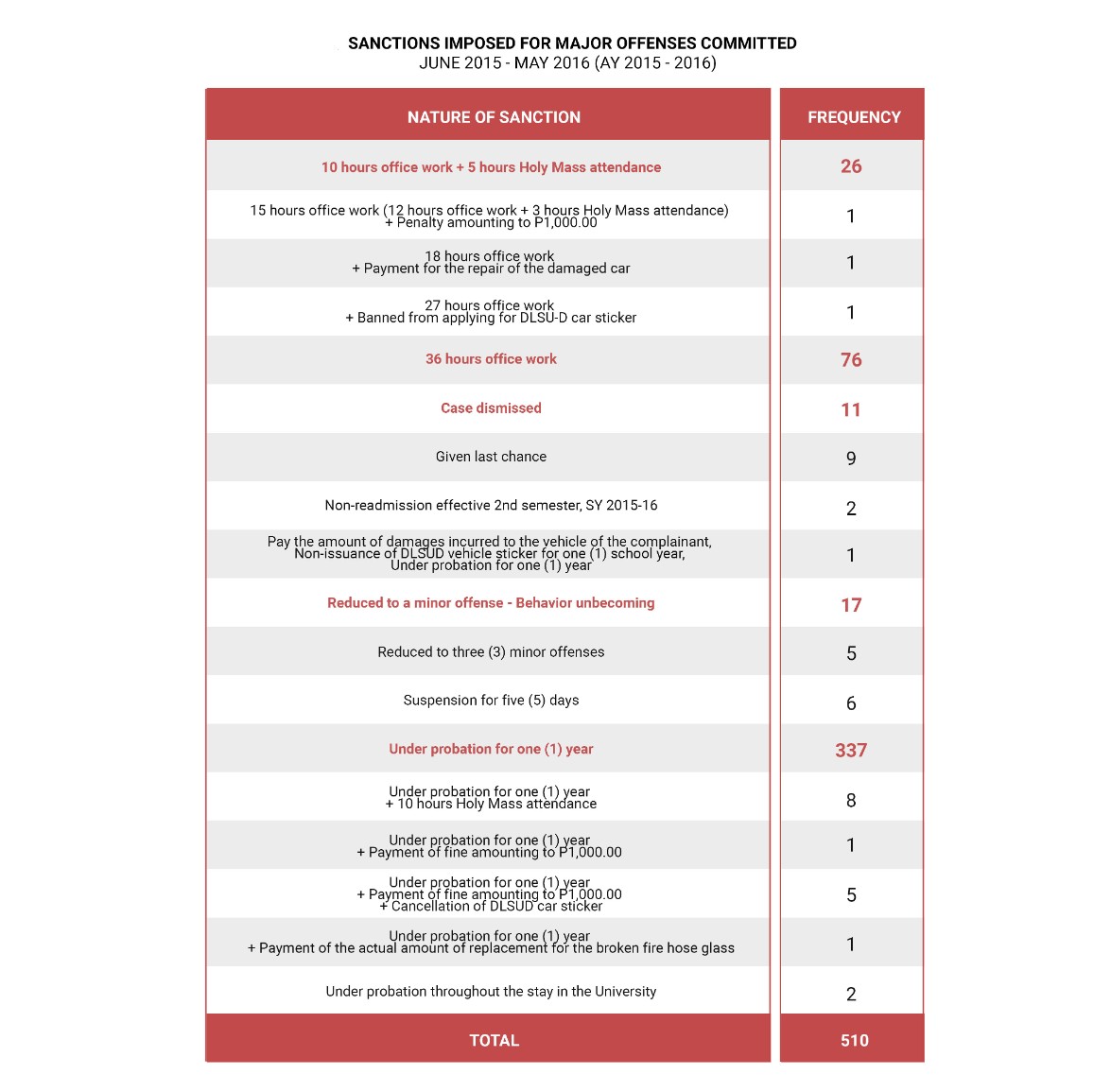
In the same AY, the five most frequently imposed sanctions for the 510 major offenses from June 2015 to May 2016 include being under probation for one year with 337 cases; 36 hours of office work with 76 cases; 10 hours of office work and 5 hours of Holy Mass attendance with 26 cases; reduction to minor offense with 17 cases; and the case dismissed with 11 cases.
As for the colleges, Casidsid reminded them to be more responsible since there are rules and regulations needed to be observed and followed.
“Kasi most of the times, ‘yong mga estudyante kapag nandito sa amin (office) ‘Ay, sir bawal po pala, hindi nami nalam,’ Ay nako, ignorance of the law excuses no one,” he furthered.
Consistency of SWAFO
With regard to the increasing number of students committing violations each AY, Casidsid said, “’Yong mga nahuhuli [na students] eh mas marami ‘yong nasa ilalim ng iceberg—‘yong hindi nahuhuli. Kaya nasasabi niyong napaka-biased ng SWAFO. Ayun lang naman, so bear with us … Unang-una, bakit ka magtatago kung ikaw ay law-abiding student, ‘di ba ‘yon lang naman ang point namin. If you follow the norm at wala tayong problema ‘di ba, sana eh ‘di wala kami. Students must always follow the norm.”
With 10 formators from SWAFO divided between the education, lost and found, and investigation sections of the office, he explained that they are being “outnumbered” by the large population of students in the University which results in the alleged “biases” of SWAFO.
“They (SWAFO formators) are only 10. And how many are you (students) in the University? I think 15,000, 13,000. Dami-dami niyan. ‘Di talaga namin makikita [lahat] and besides, ang trabaho ng formator is not just to go to different colleges and look for those violators—no.. Part of their work is to investigate the cases being filed to us at ang dami no’n,” he said.
As of press time, the revision meetings of the DLSU-D Student Handbook for the AYs 2018-2022 are currently ongoing and the topics of student attire, offenses, violations, and other sanctions are among the matters being discussed. With a report from Yna Marisse Sodoy.
This is an extended version of the article of the same headline that was originally published in The HERALDO FILIPINO Broadsheet, Volume 32, Issue 3.


